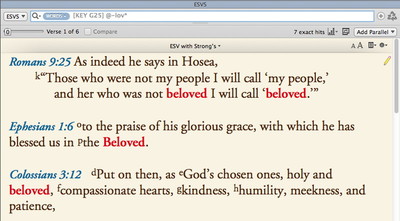In last week’s Throwback Thursday post, I talked about how adding support for Strong’s Numbers was at the top of our list of features to add in Accordance 4.0. I also wrote that every other implementation of Strong’s numbers we had seen was “ugly and inelegant.”
At that time, every Bible program we had seen that featured a Strong’s tagged Bible required you to view the Strong’s numbers in the text itself. Like this:
Obviously, showing all those numbers in the text itself makes the text hard to read. What’s more, the numbers themselves are only useful as a link to the Greek and Hebrew words they represent. People who viewed the Strong’s numbers in this way weren’t really interested in the numbers at all. They would have to double-click a number to open a Greek or Hebrew dictionary entry for the word that number represented. Only then would they have learned anything useful.
We decided there was no reason to show the numbers in the text like this. Instead, we chose to handle Strong’s numbers in the same way we already handled the grammatical tags in our Greek and Hebrew Bibles. Strong’s Numbers would remain hidden until you moused over a word, then the Strong’s number, the Greek or Hebrew word it represented, and a basic English gloss would appear in the Instant Details box. Triple-clicking a word tagged with a Strong’s number would open the dictionary entry for the Greek or Hebrew word it represented. You would also be able to search by Strong’s number just like you could a grammatical tag.
A surprisingly short while after we planned our Strong’s number implementation, our lead programmer had me come over to see the new features in action. He showed me all the features we had discussed: mousing over a word to see the Strong’s number info in the Instant Details, triple-clicking to open a Greek or Hebrew dictionary, and searching by Key number. Then he did something that blew me away. He added an ‘at symbol’ (@) after the Key number he had searched for, a minus sign after that, then typed an English word, and performed the search. Like this:
As you can see, this search finds instances where Key number G25, which represents the Greek word agapao, is not (remember that minus sign?) translated by some form of the word “love.” I remember saying, “Wow! I didn’t realize you were going to do that!” Yet Accordance had long been able to combine words and tags in Greek and Hebrew, so why not do the same thing with Strong’s numbers?
By treating Strong’s numbers as tags rather than as part of the text, we came up with new ways to search Strong’s-tagged Bibles, making Strong’s stronger than ever before.



